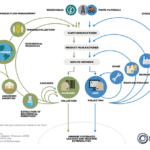
I assure you that in recent years, you have been hearing the word ‘innovation’ more frequently, whether in product or service advertisements, in courses, seminars, or workshops, or perhaps from a friend or colleague. We can say that ‘innovation’ is in vogue. However, what is innovation? In this article, we want to answer that question in a simple and practical way.
Today, the word ‘innovation’ is everywhere, and we all want to be, or at least appear to be, innovative. This has led to many academic, business, and third-sector organizations incorporating the term ‘innovation’ into their vision, mission, and objectives. Even politicians mention it regularly in their speeches (though they may not know what it truly means).
Innovation has become the lifeblood of modern businesses, driving industries and revolutionizing the way we live and work.
As a result, companies and organizations that want to lead their sectors have been creating departments or management systems that foster innovation. Similarly, centers to promote and generate innovative products or services have been proliferating in universities.
Scientific studies report that the ability to innovate, whether conceptualized as a process or as an outcome, affects the performance of companies. Small businesses can use many different forms of capabilities to innovate (Saunila, 2020). On the other hand, innovation is the only way for countries to ensure sustainable long-term productivity growth (Bloom et al., 2019), and, above all, to guarantee a competitive advantage.
We live in a highly competitive world. Therefore, the ability to create economic value through the introduction of new products or services to the market, the redesign of production processes, or the reconfiguration of organizational practices is critical for the competitive advantages of organizations, industries, or countries.
The “Holy Grail” of Development
Innovation has become the “Holy Grail” of economic growth and sustainability agendas worldwide, and many countries have been crafting policies, plans, and even implementing programs and projects to promote the emergence of innovations that contribute to the competitiveness and development of each nation.
Undoubtedly, the experiences of countries like the USA, South Korea, Israel, and Singapore, among others, teach us that the path of research and innovation is crucial in the pursuit of well-being for the population, but above all, for economic development and prosperity of societies.
However, the capacity for innovation is not sustained solely by “sparks” of creation but by ecosystems that promote it, allowing access to funds, human capital, and infrastructure. In this way, policies become the main drivers to foster innovation in a city, region, or country.
What does innovation mean?
Surely, in your daily activities or information searches, you have come across terms such as invention, creativity, and science, which are often used as if they were synonymous with innovation.
In a practical sense, we could indicate that invention is the first occurrence of an idea for a new product or process, while innovation is the first attempt to put it into practice and create value. Clear enough? Don’t worry; we will discuss this in more detail later on.
Innovation can be seen as the art of creating something new or improving existing products, processes, or services. It goes beyond merely generating ideas; it is about turning those ideas into reality. Innovation involves breaking boundaries, challenging the status quo, and embracing change. It requires thinking differently and finding creative solutions to problems.
If we want to talk about innovation from a theoretical point of view, we have to refer to the theories of Schumpeter (1934), who studied how companies seek new opportunities and competitive advantages over their current or potential competitors, which is the greatest influence for innovation.
Creative Destruction
Schumpeter also introduced the concept of “creative destruction” to describe the disruption of existing economic activities by innovations, in order to create new ways of producing goods or services, or new industries. In other words, he laid the groundwork for fostering innovative processes in companies as well as organizations.
As you may have noticed, innovation is not a new concept; it has been around for some years. However, the most widely accepted definition (due to its use in establishing indicators that allow for comparing the development of innovation systems across countries) is as follows:
“An innovation is a new or improved product or process (or a combination of both) that significantly differs from previous products or processes and that is made available to potential users (product) or has been put into use by the unit (process)” according to the Oslo Manual published by OECD/Eurostat (2019).
On their part, Cirera and Maloney (2017) emphasize that innovation can also be defined as the ability to use knowledge to develop and apply new ideas that result in changes in the production and organizational structure of the company.
Another definition of innovation is the implementation of a new or significantly improved product, service, or process that creates value for a business, government, or society. A common mistake is to believe that innovation must be entirely new and radical, and incremental innovation hardly counts (Kahn, 2018).
The broad application of the innovation concept is the fact that organizations accumulate knowledge to apply these new ideas in different ways. Kahn (2018) describes innovation as three different things: it is a process, it is an outcome, and it is a way of thinking.
This not only includes Research and Development (R&D) activities but also other accumulated knowledge from activities, often informal or through collaboration with other companies, learning from customers, or participating in global value chains or international markets.
Importance of innovation
As I explained at the beginning of this article, innovation is essential for organizations and businesses to adapt to a changing environment.
Innovation is crucial for companies to thrive in the current competitive landscape. It is not just about creating new products or services but also about finding better ways of doing things. Innovation allows companies to differentiate themselves from their competitors and create a unique value proposition. It helps them stay relevant and adapt to changing customer needs and market trends.
In their research, Muhamad et al. (2023) found that innovative work behavior and organizational commitment can create successful business performance, such as increased sales, profits, satisfaction, market share, high productivity, employee loyalty, and low employee turnover.
Innovation also plays a vital role in driving economic growth. It leads to the creation of new jobs, attracts investments, and stimulates technological advancements. In today’s global economy, countries and regions that prioritize innovation are more likely to succeed and prosper.
In this regard, Ramadani and Gerguri (2010) point out that the importance and definition of innovations can be explained from various perspectives:
- From the customers’ perspective, innovation leads to products with better quality and better service, resulting in an improved quality of life.
- From the business perspective, innovation leads to sustainable growth and development and higher profits.
- For employees, innovation leads to new and more interesting jobs that require higher skills and preparation, resulting in higher wages.
- From the perspective of the entire economy, innovation represents higher productivity and prosperity for all.
By now, you will have realized that innovation is important for improving living standards and can affect individuals, institutions, economic sectors, and countries in various ways. Likewise, innovation can make a difference in addressing urgent challenges such as access to clean water, eradicating diseases, or reducing hunger (OECD, 2012).
What do we understand by Innovation, Creativity, Invention, and Science?
In this journey of implementing innovation processes, you will come across terms like creativity, invention, and science, which are related to innovating and are often mistakenly used as synonyms. In Table 01, we present in a practical way the differences that exist between these terms.
Table 01. Differences between Innovation, Creativity, Invention, and Science
| Innovation vs Invention | Innovation vs Creativity | Innovation vs Science |
| Invention is the creation of a new concept. Innovation is bringing this concept to practice and turning it into a commercial success. | Creativity is generating ideas. Innovation is giving life to those ideas. | Science is the conversion of money into knowledge. Innovation is the conversion of knowledge into money. |
As you may have concluded, innovating is more than just having a new idea or an invention; it requires implementation. In other words, inventions and patents exist everywhere; however, if they are not adopted and used by users, or if they do not generate value for those who use them, they will simply remain as good ideas.
The economic and social impacts of inventions and ideas depend on the diffusion and assimilation of the related innovations.
Dimensions of Innovation
Well, let me tell you a bit about the dimensions of innovation. In this regard, the OECD/Eurostat (2019) highlight that innovation theories emphasize four measurable dimensions: knowledge, novelty, implementation, and value creation.
Knowledge
Innovations stem from knowledge-based activities that involve the practical application of existing or newly developed information and knowledge. Information, on the other hand, consists of organized data and can be reproduced and transferred between organizations at low cost. Finally, knowledge refers to the ability to understand the information and the skill to use it for different purposes.
Novelty with respect to potential uses
Knowledge can be used to develop new ideas, models, methods, or prototypes that can form the basis of innovations. The novelty of an innovation is related to its potential uses.
Implementation and current use
For a new idea, method, or prototype to be considered an innovation, it needs to be implemented. Implementation requires organizations to make systematic efforts to ensure that the innovation is accessible to potential users.
Value creation
Seen as an economic activity, innovation requires resources that could be used for other purposes. The existence of opportunity costs implies the likely intention of pursuing some form of value creation (or value preservation) by the actors responsible for an innovation activity.
Therefore, value is an implicit objective of innovation, but it cannot be guaranteed ex ante because the outcomes of innovation are uncertain and heterogeneous.
Why do organizations innovate?
Organizations, especially companies, innovate due to changes in user or customer attitudes and preferences, market globalization, new technologies, changes in the environment (e.g., new laws), responses from competitors, etc. In this way, organizations face new challenges by adopting new approaches.
The OECD (2012) indicates that innovation is important at all stages of development, and different types of innovation play different roles at various stages. In the early stages, incremental innovation is often associated with the adoption of external technology, and social innovation can improve the effectiveness of businesses and public services.
Types of innovation
There are many classifications to define types of innovation. In Table 2, we present the two most well-known types, but don’t worry, in other articles, we will present other classifications and delve into them.
Among the two types of innovations presented, the most sought after by innovators and companies is the “radical” type because it generates significant changes in markets and sectors. However, incremental innovations are also important; sometimes, improving “1%” can provide organizations with some competitive advantages when accumulated over a year or two.
Table 2. Types of Innovations.
| Incremental | Radical |
| Exploits existing technology Low uncertainty Focused on cost or improved features of existing processes, products, or services Improves competitiveness within current markets or industries | Explores new technology High uncertainty Focused on products, processes, or services with unprecedented features Creates dramatic changes that transform existing markets or industries, or create a new one. |
Innovating as a Result
On the other hand, if we consider innovation as a result, Kahn (2018) highlights that innovation as a result includes:
- Products: developing or improving a specific product. There are seven types of innovations recognized: cost reductions, product improvements, new features/options, new markets, new uses, new categories, new products.
- Services: offering new or improving existing services.
- Process: finding new ways to organize and combine inputs in the production process of specific products or services. Production systems, service delivery systems, and organizational processes are fertile areas for innovation processes.
- Organization: creating new ways to organize a company’s resources. Changes may occur in the structure, new management approaches, and work environments.
- Commercialization: the goal is to link sellers and consumers at new and different levels, and may include new types of promotional efforts.
- Business model: is the result of changes in the industry. Three main types of business model innovation include industry innovation model, revenue model innovation, and company model innovation.
- Supply chain: a change within the supply chain, supply chain technology, or supply chain processes that can take place within a company, an industry, or a supply chain with the purpose of creating value for all involved.
Sources of Innovation
By now, you might be tired of so much theory and eager to know how to start innovating. You might be wondering, “How can I start innovating?”
Let me tell you that a study by IBM on potential sources of innovation, based on surveys of presidents of large companies and corporations, concluded that 76% of new ideas come from collaboration with business partners and customers, while 14% come from internal research and development departments. Surprised?
The main source of innovation comes from business partners and customers. In this sense, you need to start getting to know your customers. What do they think? What do they believe? What are their habits? among other things. But it doesn’t end there; you also need to be aware of the trends in the sector in which you operate or changes in current regulations. These aspects, among others, can be sources of innovation.
On the other hand, von Hippel (2005) highlights that innovation has been democratized because users (consumers or companies) of products and services are capable of innovating themselves, and user-centered innovation offers significant advantages over manufacturer-centered innovation. This is an interesting trend because there are many examples where innovations originated from users.
Finally, research conducted by Wright (2011) reveals other sources of innovation that you should consider when you want to innovate:
- Monitor the market carefully. Unexpected changes in market or industry structure can provide potential opportunities for innovation. Changes in demographics, social aspects, values, norms, and styles may require innovative solutions for emerging needs.
- Current customers are often a valuable source. Customers can provide valuable data on unsatisfied needs and opinions about current products/services, allowing you to generate new solutions for existing problems.
- Suppliers also provide valuable input. Developing alliances with key suppliers will facilitate open discussions to identify emerging business needs and possible innovative solutions that allow for better integration of both businesses.
- Learn from experience. The experiences of the company’s team or management can be a valuable source for innovation. Unexpected successes or failures can provide new and potentially important information.
In Table 03, we present a series of elements of the innovation process with their respective strategic orientations and questions that can help you initiate your own innovative processes. However, in additional articles, we will delve into these orientations and provide information on some tools that can assist you in these processes.
Table 03. Understanding Innovation.
| Element | Strategic Orientation | Strategic Question | Considerations |
| Innovation is a result | Product or service | What do you want to happen? | Product Process Commercialization Business model Supply chain Organizational |
| Innovation is a process | Forms and means | How to make it happen? | Innovation process Product development process |
| Innovative mindset | State | What must be instilled and rooted to prepare for the what and how? | Individual mindset Organizational culture |
Principles and Strategies of the Innovator
Peter Drucker (1993) listed several principles that innovators should respect:
- Innovation begins with the analysis of opportunities. These are unexpected events, process disagreements, process requirements (the need for a new process), unexpected changes in industry or market structure, changes in demographics, changes in perception, importance, and new knowledge.
- Innovation is a conceptual and perceptual activity. The second imperative of innovation is to go out and see, ask and listen. Successful innovators work analytically on the question of what the innovation should be to satisfy an opportunity.
- Innovation, to be successful, must be simple and focused. If the innovation is not simple, it will not be successful. All successful innovations are surprisingly simple.
- Innovation should start “small.” Innovation should not be grandiose; it should be something specific and concrete.
- A successful innovation aims for leadership. If an innovation from the beginning does not aim for leadership, it is very likely not “innovative” enough.
- Innovations should not be too “smart.” Innovations should be led by simple people.
- Do not do many things at once. The innovation process requires concentrating energy and efforts.
- Do not innovate for the future but for the present. An innovation can have a long-term impact, but it requires a longer time to reach maturity. Innovation must be a solution to present problems.
Innovation Process
Innovation is not a random or fortuitous process; it requires a structured approach. In this sense, managing the innovation processes in organizations is often a challenging task for managers or administrators, requiring the development of certain competencies. However, it is also important to recognize that there are many causes for the failure of innovation processes, and you must understand that innovation is not a linear process.
Lendel et al. (2015) define “the innovation process as a sequence of activities aimed at creating and implementing innovation. This includes activities related to generating innovative ideas, their evaluation, creating the innovation, and ensuring its dissemination among customers.”
In this framework, the innovation process usually consists of several stages:
- Idea generation: This is the stage where ideas are generated. This can be done through idea exchange sessions, market studies, customer feedback, or harnessing employee creativity.
- Evaluation: Once ideas are generated, they must be evaluated to determine their feasibility and potential impact. This involves assessing factors such as market demand, technical feasibility, and financial viability.
- Development: This is where ideas are turned into prototypes or working models. It involves refining the concept, conducting further research, and testing the idea in real-world scenarios.
- Implementation: This is the stage where the idea is brought to the market or implemented within the organization. It involves developing a detailed plan, securing the necessary resources, and executing the idea.
- Monitoring and improving: After implementation, it is important to monitor the performance of the idea and make necessary improvements. This involves gathering feedback, analyzing data, and iterating on the idea to optimize its impact.
Innovation Culture
How do we promote an innovation culture in organizations?
Patmawati et al. (2023) investigated the short and long-term beneficial effects of adopting quality improvement management on product innovation performance, and they concluded that maximizing innovation returns and improving quality requires considering the individual soft and hard properties of quality improvement management and the timing and sequence of its application.
Thus, it is important to emphasize that to foster an innovation culture, it must be based on prior strategies for developing soft skills such as quality management, leadership, etc.
On the other hand, Ungureanu et al. (2016) describe that “the culture of innovation represents the sum of all practices and results prior to the innovation process carried out by the organization in order to achieve its innovation objectives.”
The culture of innovation implies the existence of a (innovative) mindset such that each person in the organization must understand the role and objective of innovation. The culture that supports the innovation process must be promoted by encouraging new ideas, communication, collaboration, being aware of conflicts, tolerance in case of failure, etc.
To foster innovation, companies must create a culture that fosters and supports it. Here are some strategies to create an innovation culture:
- Encourage open communication: foster an environment in which employees feel comfortable sharing their ideas and opinions. Encourage open dialogue and provide platforms for collaboration and knowledge exchange.
- Empower employees: Offer employees autonomy and freedom to explore new ideas and take risks. Encourage experimentation and provide resources and support for innovation projects.
- Reward and recognize innovation: Celebrate and reward employees for their innovative ideas and contributions. This can be done through recognition programs, bonuses, or promotion opportunities.
- Provide training and development: Invest in training and development programs that foster creativity, problem-solving, and critical thinking skills. Provide employees with the tools and knowledge they need to innovate.
- Lead by example: Leaders play a crucial role in fostering an innovation culture. They must lead by example, demonstrate a willingness to embrace change, and encourage innovation at all levels of the organization.
Innovative Mindset
Are we born innovators or do we learn to be innovators? Fortunately, researchers conclude that we can learn to be innovators. This implies that we must develop an innovative mindset. While innovative thinking may be innate in some cases, it can also be developed and strengthened through practice.
So, if researchers say that we can develop an innovative mindset, what is the way forward? Undoubtedly, a starting point is creativity. Thus, we must strengthen this characteristic in the individuals who are part of an organization.
The innovative mindset drives the internalization of innovation by the members of an organization, and it is a task that must be fostered and strengthened by the leaders of the organizations.
The five skills to promote new ways of thinking, stimulate and support the innovation process, and can be learned, according to Dyer, Gregerson, and Christensen (2009), are:
- Association: Establishing connections between questions, problems, or ideas from unrelated fields. The more diverse our experiences and knowledge, the more our brain can make connections.
- Questioning: Positing questions that challenge conventional wisdom. “The important and difficult work is not finding the right answers, it is finding the right question,” said Peter Drucker.
- Observing: Scrutinizing the behavior of customers, suppliers, and competitors to identify new ways of doing things.
- Experimenting: Building interactive experiences and eliciting unorthodox responses to see what ideas arise. Experimentation is often thought to be the domain of scientists; however, innovators are continually testing new ideas by creating prototypes and launching pilots. “The world is their laboratory.”
- Networking: Connecting with people with different ideas and perspectives.
Also, to these skills, we can add the use of methodologies and tools, such as “Design thinking,” a people-centered innovation approach, to promote and drive the processes.
How to overcome barriers to innovation?
While innovation is crucial for success, there are often barriers that can hinder the process. Some common barriers to innovation include:
- Resistance to change: People are naturally resistant to change, and this can hinder innovation efforts. Overcoming resistance requires effective change management strategies and clear communication.
- Lack of resources: Innovation requires resources, both financial and human. A lack of resources can limit innovation efforts. It is important to allocate resources strategically and seek external partnerships if necessary.
- Risk aversion: Fear of failure or taking risks can stifle innovation. Fostering a culture of experimentation and learning from failure can help overcome risk aversion.
- Silos and lack of collaboration: Innovation often requires collaboration between different teams or departments. Breaking down silos and fostering cross-functional collaboration is essential for successful innovation.
Conclusion
If you have made it this far, it means that you enjoyed this article. Now, let’s conclude with some key elements for innovation: novelty and value creation for the user.
Innovation is the key to staying competitive and thriving in today’s fast-paced world. It involves thinking differently, challenging the status quo, and finding creative solutions to complex problems. Innovation drives growth, increases productivity, and fosters a culture of continuous improvement. By embracing innovation, companies can stay ahead, meet changing customer needs, and create a sustainable future. Let’s unleash the power of innovation and seize the opportunities it brings.
We must highlight that there are different types of innovation, and it’s important to know the principles that innovators should follow and the sources or origins of ideas to initiate innovation processes. Additionally, fostering a culture of change focused on generating value for users, based on an innovative mindset from all members of each organization, is crucial.
The ability to innovate has become an essential skill for today’s workforce, and it will continue to be so in the future. As a professional, you must strengthen your competencies to remain competitive, and as an educator, you have an obligation to foster a creative and innovative spirit among your students.
Internationally, various countries have implemented public policies that promote innovation as part of their strategy to ensure competitiveness and economic development among their companies and societies. In this sense, we must follow the path outlined, adapting the tools to our own reality.
In conclusion, innovation is not just a trendy buzzword; it is the driving force behind the success of companies and industries. By adopting a culture of innovation, organizations can stay ahead of the competition, meet changing customer needs, and create a sustainable future. Let’s unleash the power of innovation and seize the opportunities it brings.
Finally, if we want to promote innovation processes in companies, Bloom et al. (2019) emphasize that, in the short term, public policies such as tax credits for research and development and direct public financing seem to be the most effective. Meanwhile, increasing the supply of human capital (the number of professionals in science, technology, engineering, and mathematics fields) is more effective in the long run.
References
Bloom, Nicholas, John Van Reenen, and Heidi Williams. 2019. “A Toolkit of Policies to Promote Innovation.” Journal of Economic Perspectives, 33 (3): 163-84.
DOI: 10.1257/jep.33.3.163
Cirera X. and W. Maloney. 2017. The Innovation Paradox. Developing-Country Capabilities and the Unrealized Promise of Technological Catch-Up. International Bank for Reconstruction and Development / The World Bank. 217 p.
Dyer J., Hal Gregersen and Clayton M. Christensen. 2009. The Innovator’s DNA. Harvard Business Review.
Drucker FP. 1993. Innovation and Entrepreneurship. Harper & Row Publishers Inc.: New York, NY.
Feldman M. 2004. The Significance of Innovation. Rotman School of Management, University of Toronto: Toronto.
Kahn K. 2018. Understanding innovation. Business Horizons. Volume 61, Issue 3, May–June 2018, Pages 453-460.
Lendel V., S. Hittmár, E. Siantová. 2015. Management of Innovation Processes in Company. Procedia Economics and Finance 23 ( 2015 ) 861 – 866.
Muhamad, L. F., Bakti, R., Febriyantoro, M. T., Kraugusteeliana, K., & Ausat, A. M. A. (2023). DO INNOVATIVE WORK BEHAVIOR AND ORGANIZATIONAL COMMITMENT CREATE BUSINESS PERFORMANCE: A LITERATURE REVIEW. Community Development Journal: Jurnal Pengabdian Masyarakat, 4(1), 713-717.
OECD. (2012). Innovation for Development: A DISCUSSION OF THE ISSUES AND AN OVERVIEW OF WORK OF THE OECD DIRECTORATE FOR SCIENCE, TECHNOLOGY AND INDUSTRY. 33 p.
OECD/Eurostat (2019), Oslo Manual 2018: Guidelines for Collecting, Reporting and Using Data on Innovation, 4th Edition, The Measurement of Scientific, Technological and Innovation Activities, OECD Publishing, Paris/Eurostat, Luxembourg,
Patmawati, S., Dewi, V. M., & Asbari, M. (2023). THE Effect of Short-Term and Long-Term Learning in Quality Management and Innovation. Journal of Information Systems and Management (JISMA), 2(1), 21-26.
Ramadani, Veland & Gerguri, Shqipe. (2010). Innovation: Principles and Strategies. University Library of Munich, Germany, MPRA Paper.
Saunila Minna. 2020. Innovation capability in SMEs: A systematic review of the literature. Journal of Innovation & Knowledge, Volume 5, Issue 4, 2020, Pages 260-265,
ISSN 2444-569X, https://doi.org/10.1016/j.jik.2019.11.002.
Ungureanu M., N. Pop, N. Ungureanu. 2016. Innovation and Technology Transfer for Business Development. Procedia Engineering 149 ( 2016 ) 495 – 500.
Von Hippel E. 2005. Democratizing Innovation. The MIT Press. London, England. 217 p.
Wright, P, 2011. Sources of Innovation: Where to Look.





